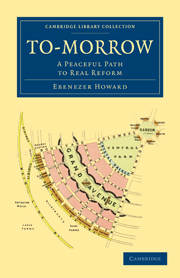Book contents
- Frontmatter
- Contents
- LIST OF ILLUSTRATIONS
- Introduction
- Chap. I The Town-Country Magnet
- Chap. II The Revenue of Garden City, and how it is obtained—The Agricultural Estate
- Chap. III The Revenue of Garden City—Town Estate
- Chap. IV The Revenue of Garden City—General Observations on its Expenditure
- Chap. V Further Details of Expenditure on Garden City
- Chap. VI Administration
- Chap. VII Semi-Municipal Enterprise—Local Option—Temperance Reform
- Chap. VIII Pro-Municipal Work
- Chap. IX Administration—A Bird's Eye View
- Chap. X Some Difficulties Considered
- Chap. XI A Unique Combination of Proposals
- Chap. XII The Path followed up
- Chap. XIII Social Cities
- Chap. XIV The Future of London
- APPENDIX: Water-Supply
- INDEX
- Plate section
Chap. VII - Semi-Municipal Enterprise—Local Option—Temperance Reform
Published online by Cambridge University Press: 05 February 2012
- Frontmatter
- Contents
- LIST OF ILLUSTRATIONS
- Introduction
- Chap. I The Town-Country Magnet
- Chap. II The Revenue of Garden City, and how it is obtained—The Agricultural Estate
- Chap. III The Revenue of Garden City—Town Estate
- Chap. IV The Revenue of Garden City—General Observations on its Expenditure
- Chap. V Further Details of Expenditure on Garden City
- Chap. VI Administration
- Chap. VII Semi-Municipal Enterprise—Local Option—Temperance Reform
- Chap. VIII Pro-Municipal Work
- Chap. IX Administration—A Bird's Eye View
- Chap. X Some Difficulties Considered
- Chap. XI A Unique Combination of Proposals
- Chap. XII The Path followed up
- Chap. XIII Social Cities
- Chap. XIV The Future of London
- APPENDIX: Water-Supply
- INDEX
- Plate section
Summary
“It has been calculated by Mr. Neale” (“Economics of Cooperation”) “that there are 41,735 separate establishments for 22 of the principal retail trades in London. If for each of these trades there were 648 shops—that is 9 to the square mile, no one would have to go more than a quarter of a mile to the nearest shop. There would be 14,256 shops in all. Assuming that this supply would be sufficient, there are in London 251 shops for every hundred that are really wanted. The general prosperity of the country will be much increased when the capital and labour that are now wastefully employed in the retail trade are set free for other work.”
—“Economics of Industry,” A. and M. P. Marshall, Chap, ix., sec. 10.In the last chapter we saw that no line could be sharply drawn between municipal and individual enterprise, so that one could definitely say of one or the other, “Hitherto shalt thou come, but no further”; and this ever-changing character of the problem can be usefully illustrated in our examination of the industrial life of Garden City by reference to a form of enterprise there carried on which is neither distinctly municipal nor distinctly individualistic, but partaking, as it does, of the character of both, may be termed “semi-municipal.” (See Diagram 5.)
Among the most reliable sources of revenue possessed by many of our existing municipalities are their so-called “public markets.”
- Type
- Chapter
- Information
- To-morrowA Peaceful Path to Real Reform, pp. 72 - 81Publisher: Cambridge University PressPrint publication year: 2010First published in: 1898

